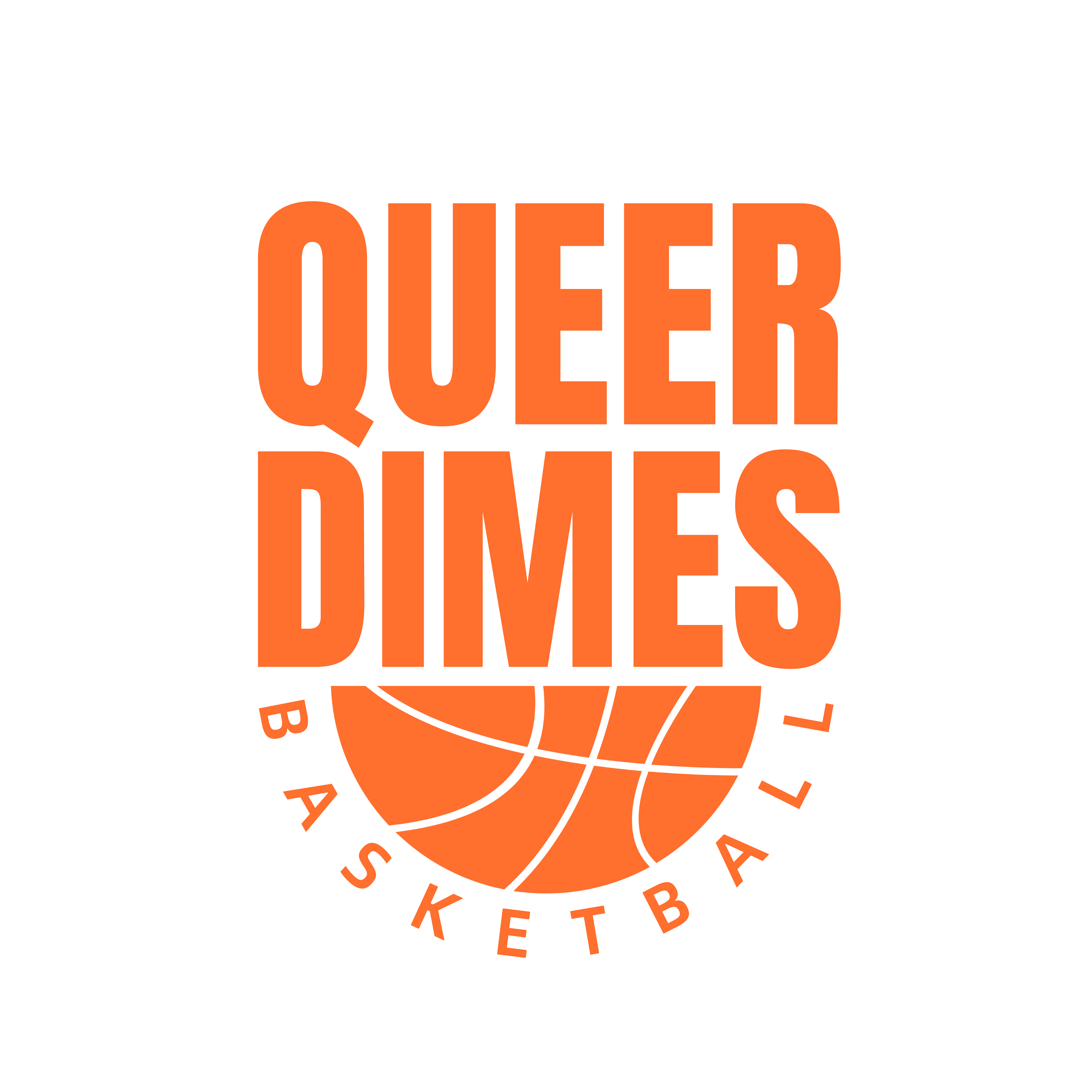BASKETBALL 101
with STAC Hamilton
You do not need to know or memorize these rules and terms in order to come play on a Queer Dimes court. You will learn through playing and with the help of the people around you. Don't let a current lack of knowledge stop you from coming out to play.
Note: This is not an extensive list of basketball rules and terms. It mainly includes things that are relevant to how we play.
INTRO TO BASKETBALL
‣ Basketball is a game played between two teams of five players each on a rectangular court, usually indoors. Each team tries to score by tossing the ball through the opponent's goal, an elevated horizontal hoop and net called a basket.
‣ Basketball is a team sport typically played 5v5 but can be played 4v4, 3v3, 2v2 or 1v1 using half the court, depending on how many people are playing.
‣ Dribble or pass to move the ball. Players are not allowed to take more than two steps after picking the ball up before shooting or passing it.
‣ Full games of basketball are divided into 4 quarters of varying length depending on the level of play. When the game ends, the team with the most points wins.
TERMINOLOGY
Hoop/basket: If the ball goes in the hoop with the net (the basket), the offensive team scores or "makes a basket". The "glass", or "backboard" is the back of the hoop.
Dribble: Bouncing the ball off of the court (the floor). Players must dribble to move the ball. If you don’t dribble and you move your feet, it’s a traveling foul.
Pivot foot: Once the ball is picked up by a player, a pivot foot must be kept at its point of contact with the floor. The other foot can move as many times as the player wants.
Screen/pick: A legal move by an offensive player in which they stand beside or behind a defender in order to block them and free up a teammate to either shoot, pass, or to drive to the basket.
Free throw: When a player is fouled while shooting, they get to shoot free throws. These are worth 1 point each.
Jump ball: In official games, this is how you start the game. The ball is thrown into the air and players try to tip it to their team. This event is called the "tip off".
The paint: Also known as "the interior", this is the area of the court closest to the hoop. It is outlined by a rectangle. The top line is the free throw line.
The arc: Also known as the three point line, this is the round line on the ground surrounding the paint. In official games, making the ball from behind this line is worth 3 points.
PICK UP BASKETBALL
Pick up basketball is a more informal, spontaneous game with no official teams, coaches or referees. Rules used in pick up basketball games can vary, but in general there are a few common differences to know.
Rule #1: Half-court pickup is always make it-take it
If you’re playing half-court, the rule is if you make a basket, it's winners ball again.
Rule #2: Play by 1’s and 2’s
Inside the 3 point line is worth 1 point and outside is worth 2 points.
Rule #3: Don’t call fouls unless you really get fouled
If you get a hard slap on the hand when you’re shooting, call the foul. If it’s just a bit of a tap, let it go. Fouled teams take possession and no free throws are taken.
Rule #4: There are no timeouts
Rule #5: Any disputes are settled by shooting for it
Whatever the case, the way to decide it is by shooting for it. If the player shooting it makes it, they’re right. If they miss, the call goes against them - "ball don’t lie".
Rule #6: Respect the peaceful transition of power
The team that wins the game stays on the court.
FOULS
Personal fouls include any type of illegal physical contact:
‣ Hitting
‣ Pushing
‣ Slapping
‣ Holding
‣ Illegal screens (when an offensive player is moving or sticks out a limb that hits someone while setting a screen)
In official games, if a player is shooting and is fouled, they take free throws. 1 free throw if the shot went in, and 2 if it didn't go in. A player takes 3 free throws if the missed shot was behind the arc (3 point line).
VIOLATIONS
Walking/Traveling: Taking more than 'a step and a half' without dribbling the ball is traveling. Moving your pivot foot once you've stopped dribbling is traveling.
Carrying/Palming: When a player dribbles the ball with their hand too far on the side of or, sometimes, even under the ball.
Double Dribble: Dribbling the ball with both hands on the ball at the same time or picking up the dribble and then dribbling again.
